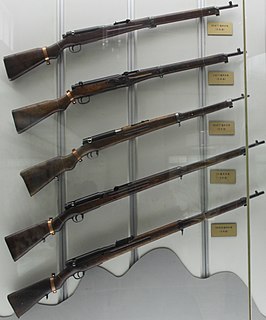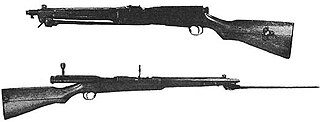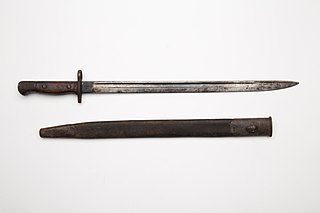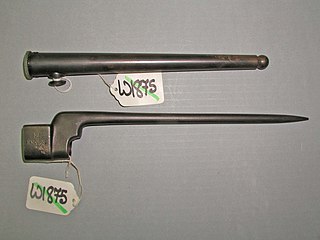
A spike bayonet , also known as a pigsticker in informal contexts, is a blade attachment for a firearm taking the form of a pointed spike rather than a knife.

A spike bayonet , also known as a pigsticker in informal contexts, is a blade attachment for a firearm taking the form of a pointed spike rather than a knife.
Most early musket bayonets were of this type. Beginning in the early 19th century, knife and/or sword bayonets began to appear, which could also be wielded by hand. In the early to mid-20th century, spike bayonets reappeared, often folding or stowed under the barrel for compactness, such as on the French Lebel M1886 and MAS-36, Russian SKS and Mosin-Nagant, German FG 42, and British Lee–Enfield. The Lee-Enfield Rifle No.4 bayonet, took the form of a short spike (but fixed conventionally), and was unpopular due to its length and lack of utility.
Spike bayonets have not been popular with armies since the end of World War II, with the exception of China, which attached them to its AK-47 rifle and SKS carbine variants (Type 56 and Type 63).

A bayonet is a knife, dagger, sword, or spike-shaped weapon designed to fit on the end of the muzzle of a rifle, musket or similar firearm, allowing it to be used as a spear-like weapon. From the 17th century to World War I, it was considered a primary weapon for infantry attacks. Today, it is considered an ancillary weapon or a weapon of last resort.

The Lee–Enfield is a bolt-action, magazine-fed repeating rifle that served as the main firearm of the military forces of the British Empire and Commonwealth during the first half of the 20th century, and was the British Army's standard rifle from its official adoption in 1895 until 1957. The WWI versions are often referred to as the "SMLE", which is short for the common "Short, Magazine, Lee–Enfield" variant.

The Arisaka rifle is a family of Japanese military bolt-action service rifles, in production and use since approximately 1897, when it replaced the Murata rifle family, until the end of World War II in 1945. The most common specimens include the Type 38 chambered for the 6.5×50mmSR Type 38 cartridge, and the Type 99 chambered for the 7.7×58mm Type 99 cartridge, which is comparable in power to a modern .308 Winchester round.
A semi-automatic firearm, also called a self-loading or autoloading firearm, is a repeating firearm whose action mechanism automatically loads a following round of cartridge into the chamber (self-loading) and prepares it for subsequent firing, but requires the shooter to manually actuate the trigger in order to discharge each shot. Typically, this involves the weapon's action utilizing the excess energy released during the preceding shot to unlock and move the bolt, extracting and ejecting the spent cartridge case from the chamber, re-cocking the firing mechanism, and loading a new cartridge into the firing chamber, all without input from the user. To fire again, however, the user must actively release the trigger, allow it to "reset", before pulling the trigger again to fire off the next round. As a result, each trigger-pull only discharges a single round from a semi-automatic weapon, as opposed to a fully automatic weapon, which will shoot continuously as long as the ammunition is replete and the trigger is kept depressed.

The M1903 Springfield, officially the United States Rifle, Caliber .30-06, Model 1903, is an American five-round magazine fed, bolt action service repeating rifle, used primarily during the first half of the 20th century.

The SKS is a semi-automatic carbine chambered for the 7.62×39mm round, designed in 1943 by Sergei Gavrilovich Simonov. A reliable, simply designed, and relatively inexpensive weapon, the SKS was first produced in the Soviet Union but later widely exported and manufactured by various nations. Its distinguishing characteristics include a permanently attached folding bayonet and a hinged, fixed magazine. As the SKS lacked select-fire capability and its magazine was limited to ten rounds, it was rendered obsolete in the Soviet Armed Forces by the introduction of the AK-47 in the 1950s. Nevertheless, SKS carbines continued to see service with the Soviet Border Troops, Internal Troops, and second-line and reserve army units for decades.
The Rifle No. 5 Mk I, was a derivative of the British Lee–Enfield No. 4 Mk I, Following experience of jungle fighting in the Pacific War the British came to "the conclusion that a rifle shorter and lighter than the standard issue, bolt action .303 cal No. 4 rifle was required." However its operational use was in post-war colonial campaigns such as the Malayan emergency, where it gained its common nickname of the "Jungle Carbine."

The Type 81 is a Chinese-designed second-generation, selective-fire, gas-operated 7.62×39mm assault rifle based on Kalashnikov and SKS actions adopted by the Chinese People's Liberation Army (PLA) and has been in service since the mid-1980s. It is a small arms family that consist of the Type 81, the Type 81-1 and the Type 81 LMG.

The Type 38 rifle is a bolt-action service rifle that was used by the Empire of Japan predominantly during the Second Sino-Japanese War and Second World War. The design was adopted by the Imperial Japanese Army in 1905. Due to a lack of strength in its 6.5×50mmSR Arisaka cartridge, it was partially replaced during the war with the Type 99 rifle, but both rifles saw usage until the end of the war.

The Type 44 Cavalry Rifle is a Japanese bolt-action rifle. This rifle is also often referred to as a Type 44 Carbine.
A sword bayonet is any long, knife-bladed bayonet designed for mounting on a musket or rifle. Its use is thought to have begun in the 18th century and to have reached its height of popularity throughout the 19th and into the early 20th centuries. When unmounted from a musket or rifle, sword bayonets with their typical hilts and long blades also could be wielded as short swords. While modern military bayonets typically have knife blades, they are usually too short to be called sword bayonets and are more akin to fighting/utility knives.

The Karabinek wz.29 was a Polish bolt-action short rifle based on the German Kar98AZ. Identifying attributes include a 98/05 style mast bayonet lug ending directly beneath the front sight and winged protective ears to either side of the front sight blade. Cavalry models featured a turned-down bolt handle, and early versions had a stacking hook near the end of the stock on the right side.

The origins of the modern British military rifle are within its predecessor the Brown Bess musket. While a musket was largely inaccurate over 80 yards (73 m), due to a lack of rifling and a generous tolerance to allow for muzzle-loading, it was cheaper to produce and could be loaded quickly. The use in volley or in mass firing by troops meant that rate of fire took precedence over accuracy.

A knife bayonet is a knife which can be used both as a bayonet, combat knife, or utility knife. The knife bayonet became the almost universal form of bayonet in the 20th century due to its versatility and effectiveness. Spike bayonets proved useless when separated from the rifle and useless in trench warfare; and while versatile, sword bayonets proved to be impractical weapons in trench warfare because of their length. The first knife bayonet to see widespread service was the 10 inch blade Seitengewehr 1871/84, which became the standard German infantry bayonet in 1884. Its derivative, the Seitengewehr 1884/98, would go on in use until 1945 in German service.

The Pattern 1907 bayonet, officially called the Sword bayonet, pattern 1907 , was a British bayonet designed to be used with the Short Magazine Lee Enfield (SMLE) rifle. The Pattern 1907 bayonet was used by the British and Commonwealth forces throughout both the First and Second World Wars.
This article is about the weapons used in the First Indochina War that involved the North Vietnam or Việt Minh, Japanese volunteers, the State of Vietnam (1949–1954) and the French Fourth Republic.
This article is about the weapons used in the Cambodian–Vietnamese War, involved the Vietnam, People's Republic of Kampuchea which of the Khmer Rouge, Khmer People's National Liberation Front, FUNCINPEC and Thailand (border clashes)

The No. 4 Bayonet was the standard bayonet for all Lee Enfield No 4 rifles.